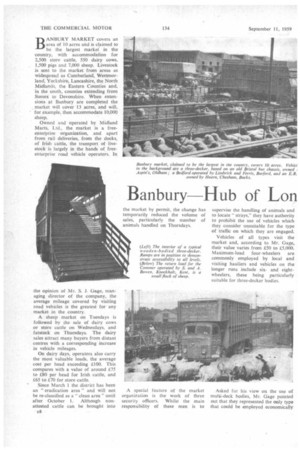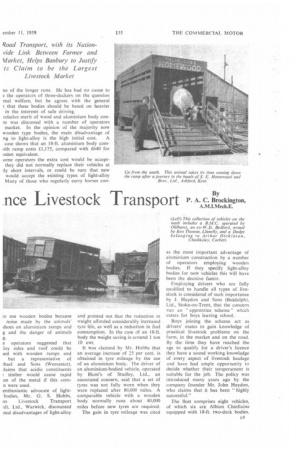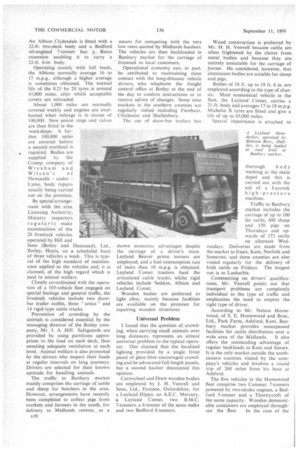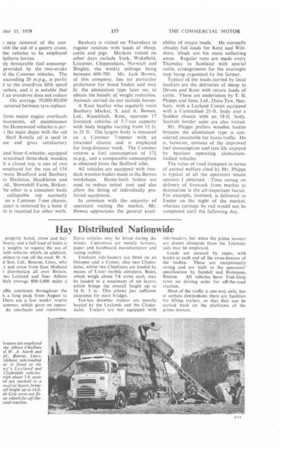Banbury Hub of Lon
Page 70

Page 71

Page 72

Page 73

If you've noticed an error in this article please click here to report it so we can fix it.
.nce Livestock Transport • A • C
By P Brockington,
A.M.I.Mech.E.
BANBURY MARKET covers an area of 10 acres and is claimed to be the largest market in the country, with accommodation for 2,500 store cattle, 550 dairy cows, 1,500 pigs and 7,000 sheep. Livestock is sent to the market from areas as widespread as Cumberland, Westmorland, Yorkshire, Lancashire, the North Midlands, the Eastern Counties and, in the south, counties extending from Sussex to Devonshire. When extensions at Banbury are completed the market will cover 13 acres, and will, for example, then accommodate 10,000 sheep.
Owned and operated by Midland Marts, Lid., the market is a freeenterprise organization, and apart from rail deliveries, from the docks, of Irish cattle, the transport of livestock is largely in the hands of freeenterprise road vehicle operators. In
-the opinion of Mr. S. J. Gage, managing director of the company, the average mileage covered by visiting road vehicles is the greatest for any market in the country.
A sheep market on Tuesdays is followed by the sale of dairy cows or store cattle on Wednesdays, and fatstock on Thursdays. The dairy sales attract many buyers from distant centres with a corresponding increase in vehicle mileages.
On dairy days, operators also carry the most valuable loads, the average cost per head exceeding £100. This compares with a value of around £75 to £80 per head for Irish cattle, and £65 to £70 for store cattle.
Since March 1 the district has been an "eradication area" and will not be re-classified as a "clean area" until after October 1. Although nonattested cattle can be brought into
F8
the market by permit, the change has temporarily reduced the volume of sales, particularly the number of animals handled on Thursdays.
A special feature of the market organization is the work of three security officers. Whilst the main responsibility of these men is to
supervise the handling of animals and to locate "strays," they have authority to prohibit the use of vehicles which they consider unsuitable for the type of traffic on which they are engaged.
Vehicles of all types visit the market and, according to Mr. Gage, their value varies from £50 to £5,000. Maximum-load four-wheelers are commonly employed by local and visiting hauliers and vehicles on the longer runs include sixand eightwheelers, these being particularly suitable for three-decker bodies.
Asked for his view on the use of multi-deck bodies, Mr. Gage pointed out that they represented the only type that could be employed economically ne of the longer runs. He has had no cause to e the operators of three-deckers on the question mal welfare, but he agrees with the general that these bodies should be based on heavier in the interests of safe driving.
relative merit of wood and aluminium body conin was discussed with a number of operators market. In the opinion of the majority now wooden type bodies, the main disadvantage of ng to light-alloy is the high initial cost. A case shows that an 18-ft. aluminium body comvith ramp costs £1,175, compared with £640 for oden equivalent.
■ orne operators the extra cost would be acceptthey did not normally replace their vehicles at :ly short intervals, or could be sure that new would accept the existing types of light-alloy Many of those who regularly carry horses con to use wooden bodies because
noise made by the animals' shoes on aluminium ramps and g and the danger of animals g.
e operators suggested that loy sides and roof could be led with wooden ramps and
but a representative of :hael and Sons (Worcester), :laims that acidic constituents timber would cause rapid on of the metal if this corn n were used.
enthusiastic advocate of lightbodies, Mr. G. S. Hobbs,
ns Livestock Transport -d), Ltd., Warwick, discounted )ted disadvantages of light-alloy
and pointed out that the reduction in weight afforded considerably increased tyre life, as well as a reduction in fuel consumption. In the case of an 18-ft. body the weight saving is around 1 ton 10 cwt.
It was claimed by Mr. Hobbs that an average increase of 25 per cent. is obtained in tyre mileage by the use of an aluminium body. The driver of an aluminium-bodied vehicle, operated by Hunt's of Studley, Ltd., an associated concern, said that a set of tyres was not fully worn when they were replaced after 80,000 miles. A comparable vehicle with a wooden body normally runs about 40,000 miles before new tyres are required.
The gain in tyre mileage was cited
(Left) This collection of vehicles on the wash includes a B.M.C. operated by Whams, an ex-W.D. Bedford, owned by Ken Thomas, Llanelly, and a Dodge belonging to Arthur Dickinson, Chaddesley, Corbett.
as the most important advantage of aluminium construction by a number of operators employing wooden bodies. If they specify light-alloy bodies for new vehicles this will have been the decisive factor.
Employing drivers who are fully qualified to handle all types of livestock is considered of such importance by J. Haydon and Sons (13iddulph), Ltd., Stoke-on-Trent, that the concern run an " apprentice scheme" which caters for boys leaving school.
Boys joining the scheme act as drivers' mates to gain knowledge of practical livestock problems on the farm, in the market and on the road. By the time they have reached the age to qualify for a driver's licence they have a sound working knowledge of every aspect of livestock haulage and have had ample opportunity to decide whether their temperament is suitable for the job. The policy was introduced many years ago by the company founder Mr. John Haydon, who claims that it has been "highly successful."
The fleet comprises eight vehicles, of which six are Albion Chieftains equipped with 18-ft. two-deck bodies. E9 An Albion Clydesdale is fitted with a 22-ft. two-deck body and a Bedford oil-engined 7-tonner has a Baico extension enabling it to carry a 22-ft. 6-in. body.
Operating mainly with full loads, the Albions normally average 16 to 17 m.p.g., although a higher average is sometimes obtained. The normal life of the 8.25 by 20 tyres is around 45,000 miles, after which acceptable covers are retreaded.
About 1,000 miles are normally covered weekly and engines are over hauled when mileage is in excess of 100,000. New piston rings and valves are then fitted in the workshops. A fur ther 100,000 miles are covered before a second overhaul is required. Bodies are supplied by the Crump company of Wrexham and Wilson's of Newcastle under Lyme, body repairs usually being carried out on the premises.
By special arrangement with the area Licensing Authority, Ministry inspectors regularly make examinations of the 20 livestock vehicles operated by Hill and Sons (Botley and Denmead), Ltd., Botley, Hants, on a scheduled basis of three vehicles a week. This is typi cal of the high standard of maintenance applied to the vehicles and, it is claimed, of the high regard which is paid to animal welfare.
Closely co-ordinated with the operation of a 105-vehicle fleet engaged on special haulage and general traffic, the livestock vehicles include two drawbar trailer outfits, three " artics " and 14 rigid-type cattle trucks.
Prevention of crowding by the animals is considered essential by the managing director of the Botley com pany. Mr. J. A. Hill. Safeguards are provided by using partitions appro priate to the load, on each deck, thus ensuring adequate ventilation at each level. Animal welfare is also promoted by the drivers who inspect their loads at regular intervals on long journeys. Drivers are selected for their known aptitude for handling animals.
The traffic to Banbury market mainly comprises the carriage of cattle and sheep for butchers in the area. However, arrangements have recently been completed to collect pigs from markets and farmers in the south, for delivery to Midlands centres, as a EIO means for competing with the very low rates quoted by Midlands hauliers. The vehicles are then backloaded in Banbury market for the carriage of livestock to local customers.
Operational economy can, in part, be attributed to maintaining close contact with the long-distance vehicle drivers, who telephone the freight control office at Botley at the end of the day to confirm instructions or to receive advice of changes. Some nine markets in the southern counties are regularly visited including Fareham. Chichester and Shaftesbury.
The use of draw-bar trailers has shown economic advantages despite the carriage of a driver's mate. Leyland Beaver prime movers are employed, and a fuel consumption rate of more than 10 m.p.g. is obtained. Leyland Comet tractors haul the articulated cattle trucks, whilst rigid vehicles include Seddon, Albion and Leyland Comet.
Wooden bodies are preferred to light alloy, mainly because facilities are available on the premises for repairing wooden structures.
Universal Problem 'found that the question of crowding, when carrying small animals over long distances, represents an almost universal problem to the typical operator. One claimed that the localized lighting provided by a single front panel of glass fibre encouraged crowding and he advocated full-length panels, but a second haulier discounted this opinion.
Carmichael and Drew wooden bodies are employed by J. H. Venvell and Sons, Ltd., Enstone, Oxfordshire, for a Leyland Hippo, an A.E.C. Mercury, a. Leyland Comet, two B.M.C. 7-tonners, a 6-tonner of the same make and two Bedford 6-tonners. Wood construction is preferred by Mr. H. H. Venvell because cattle are often frightened by the clatter from metal bodies and because they are entirely unsuitable for the carriage of horses. He considered, however, that aluminium bodies are suitable for sheep and pigs.
Bodies of 16 ft. up to 19 ft. 6 in. are employed according to the type of chassis. Most economical vehicle in the fleet, the Leyland Comet, carries a 21-ft. body and averages 17 to 18 m.p.g. Michelin X tyres are fitted and give a life of up to 65,000 miles.
Special importance is attached to thorough body washing at the main depot and this is carried out with the aid of a Laycock high-pressure machine.
Traffic to Banbury market includes the carriage of up to 100 fat cattle, 400 sheep and 150 pigs on Thursdays and upwards of 175 cattle on alternate Wednesdays. Deliveries are made from the market to Essex, Kent, Norfolk and Somerset, and these counties are also visited regularly for the delivery of Irish cattle on Fridays. The longest run is to Lockerbie.
Commenting on drivers' qualifications, Mr. Venvell points out that transport problems are completely individual to the type of traffic and emphasizes the need to employ the right type of driver.
According to Mr. Nelson Homewood, of S. E. Homewood and Bros., Ltd., Park Farm, Ashford, Kent, Ban-bury market provides unsurpassed facilities for cattle distribution over a
wide area of the Midlands. It also offers the outstanding advantage of regular backloads to Kent and Sussex. It is the only market outside the southeastern counties visited by the company's vehicles and involves a round trip of 260 miles from his base at Ashford.
The five vehicles in the Homewood fleet comprise two Commer 7-tonners powered by two-stroke engines, a Bedford 5-tonner and a Thornycroft of the same capacity. Wooden demountable containers are employed through out the fleet. In the case of the ; easy removal of the convith the aid of a gantry crane, the vehicles to be employed latform lorries.
ily favourable fuel eonsumpprovided by the two-stroke )f the Commer vehicles. The exceeding 20 m.p.g., is partly I to the overdrive fifth speed :arbox, and it is notable that f an overdrive does not reduce On average 70,000-80,000 covered between tyre replace from major engine overhauls ■ lacemcnts, all maintenance the Homewood vehicles is perLt the main depot with the aid Shell Rotella oil is used in ase and gives satisfactory Land Steer 6-wheeler, equipped armichael three-deck wooden h a closed top, is one of two employed for the run of 154 Lween Bradford and Banbury )y Hasleton, Shackleton and Ad., Brownhill Farm, Birkenle other is a container body collapsible top normally on a Commer 7-ton chassis. airier is removed by a hoist if .le is required for other work.
Banbury is visited on Thursdays in regular rotation with loads of sheep, cattle and pigs. Markets visited on other days include York, Wakefield, Leicester, Chippenham, Norwich and Bingley, the weekly mileage being between 600-700. Mr. Jack Brown, of this company, has no particular preference for wood bodies and may tit the aluminium type later on, to obtain the benefit of weight reduction. Animals carried do not include horses.
A Kent haulier who regularly visits Banbury Market, S. and A. Bowen, Ltd., Knockholt, Kent, operates 17 livestock vehicles of 5-7-ton capacity with body lengths varying from 12 ft. to 21 ft. The largest body is mounted on a Commer 7-tonner with an extended chassis and is employed for long-distance work. The Commer returns a fuel consumption of 171 m.p.g., and a comparable consumption is obtained from the Bedford oiler.
All vehicles are equipped with twodeck wooden bodies made in the Bowen workshops. Home-built bodies are used to reduce initial cost and also allow the fitting of individually preferred equipment.
In common with the majority of operators visiting the market, Mr._ Bowen appreciates the general avail ability of return loads. He normally obtains full loads for Kent and Wiltshire, 'which are his main collecting areas. Regular runs are made every Thursday to Scotland with special cattle, arrangements for the overnight stop being organized by the farmer.
Typical of the loads carried by local hauliers are the deliveries of sheep to Devon and Kent with return loads of cattle. These are undertaken by T. B. Phipps and Sons, Ltd., Duns Tew, Banbury, with a Leyland Comet equipped with a Carmichael 21-ft. body and a Seddon chassis with an 18-ft. body. Scottish border sales are also visited.
Mr. Phipps prefers wooden bodies because the aluminium type is considered unsuitable for horse traffic. He is, however, envious of the improved fuel consumption and tyre life enjoyed by hauliers operating aluminiumbodied vehicles.
The value of road transport in terms of animal welfare cited by Mr. Phipps is typical of all the operators whose opinion I obtained. Time saving on delivery of livestock from market to destination is the all-important factor. For example, livestock is delivered to Exeter on the night of the market, whereas carriage by rail would not be completed until the following day.




























































































































































